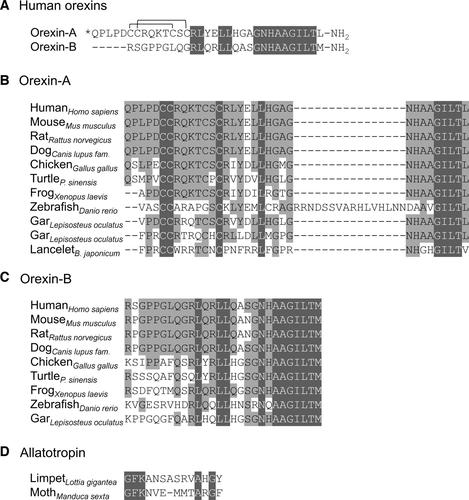当前位置:
X-MOL 学术
›
Pharmacol. Rev.
›
论文详情
Our official English website, www.x-mol.net, welcomes your
feedback! (Note: you will need to create a separate account there.)
International Union of Basic and Clinical Pharmacology CXIV: Orexin Receptor Function, Nomenclature and Pharmacology
Pharmacological Reviews ( IF 19.3 ) Pub Date : 2024-09-01 , DOI: 10.1124/pharmrev.123.000953 Jyrki P Kukkonen 1 , Laura H Jacobson 2 , Daniel Hoyer 2 , Maiju K Rinne 2 , Stephanie L Borgland 2
Pharmacological Reviews ( IF 19.3 ) Pub Date : 2024-09-01 , DOI: 10.1124/pharmrev.123.000953 Jyrki P Kukkonen 1 , Laura H Jacobson 2 , Daniel Hoyer 2 , Maiju K Rinne 2 , Stephanie L Borgland 2
Affiliation

|
The orexin system consists of the peptide transmitters orexin-A and -B and the G protein-coupled orexin receptors OX1 and OX2. Orexin receptors are capable of coupling to all four families of heterotrimeric G proteins, and there are also other complex features of the orexin receptor signaling. The system was discovered 25 years ago and was immediately identified as a central regulator of sleep and wakefulness; this is exemplified by the symptomatology of the disorder narcolepsy with cataplexy, in which orexinergic neurons degenerate. Subsequent translation of these findings into drug discovery and development has resulted to date in three clinically used orexin receptor antagonists to treat insomnia. In addition to sleep and wakefulness, the orexin system appears to be a central player at least in addiction and reward, and has a role in depression, anxiety and pain gating. Additional antagonists and agonists are in development to treat, for instance, insomnia, narcolepsy with or without cataplexy and other disorders with excessive daytime sleepiness, depression with insomnia, anxiety, schizophrenia, as well as eating and substance use disorders. The orexin system has thus proved an important regulator of numerous neural functions and a valuable drug target. Orexin prepro-peptide and orexin receptors are also expressed outside the central nervous system, but their potential physiological roles there remain unknown.
中文翻译:

国际基础和临床药理学联合会 CXIV:食欲素受体功能、命名和药理学
食欲素系统由肽递质食欲素-A 和-B 以及G 蛋白偶联食欲素受体OX 1和OX 2组成。食欲素受体能够与所有四个异源三聚体 G 蛋白家族偶联,并且食欲素受体信号传导还具有其他复杂特征。该系统于 25 年前被发现,并立即被确定为睡眠和觉醒的中央调节器;伴有猝倒的发作性睡病的症状就是例证,其中食欲素能神经元退化。随后将这些发现转化为药物发现和开发,迄今为止已产生了三种临床使用的食欲素受体拮抗剂来治疗失眠。除了睡眠和清醒之外,食欲素系统似乎至少在成瘾和奖励方面发挥着核心作用,并且在抑郁、焦虑和疼痛门控中发挥着作用。其他拮抗剂和激动剂正在开发中,用于治疗例如失眠、伴有或不伴有猝倒的发作性睡病以及其他白天过度嗜睡的疾病、伴有失眠的抑郁症、焦虑、精神分裂症以及饮食和物质使用障碍。因此,食欲素系统已被证明是许多神经功能的重要调节剂和有价值的药物靶点。食欲素前肽原和食欲素受体也在中枢神经系统外表达,但它们在那里的潜在生理作用仍然未知。
更新日期:2024-08-15
中文翻译:

国际基础和临床药理学联合会 CXIV:食欲素受体功能、命名和药理学
食欲素系统由肽递质食欲素-A 和-B 以及G 蛋白偶联食欲素受体OX 1和OX 2组成。食欲素受体能够与所有四个异源三聚体 G 蛋白家族偶联,并且食欲素受体信号传导还具有其他复杂特征。该系统于 25 年前被发现,并立即被确定为睡眠和觉醒的中央调节器;伴有猝倒的发作性睡病的症状就是例证,其中食欲素能神经元退化。随后将这些发现转化为药物发现和开发,迄今为止已产生了三种临床使用的食欲素受体拮抗剂来治疗失眠。除了睡眠和清醒之外,食欲素系统似乎至少在成瘾和奖励方面发挥着核心作用,并且在抑郁、焦虑和疼痛门控中发挥着作用。其他拮抗剂和激动剂正在开发中,用于治疗例如失眠、伴有或不伴有猝倒的发作性睡病以及其他白天过度嗜睡的疾病、伴有失眠的抑郁症、焦虑、精神分裂症以及饮食和物质使用障碍。因此,食欲素系统已被证明是许多神经功能的重要调节剂和有价值的药物靶点。食欲素前肽原和食欲素受体也在中枢神经系统外表达,但它们在那里的潜在生理作用仍然未知。






























 京公网安备 11010802027423号
京公网安备 11010802027423号